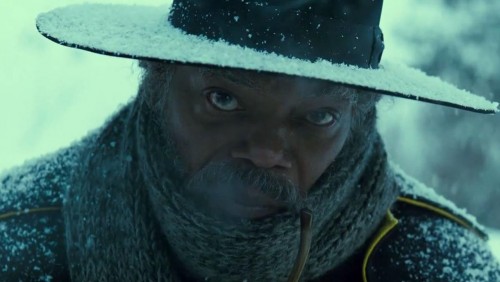Review: The Hateful Eight (Roadshow Version)
Quentin Tarantino’s eighth film, The Hateful Eight, sees him go full-on Western after Django Unchained’s “Southern”. A gang of Tarantino’s regular players: Kurt Russell (Death Proof), Samuel L. Jackson (Pulp Fiction), Tim Roth and Michael Madsen (Reservoir Dogs), plus Zoe Bell, Walton Goggins and Bruce Dern (Django Unchained), are joined by some perfectly picked fresh blood in the forms of Jennifer Jason Leigh (eXistenZ) and Channing Tatum (Magic Mike).
John “The Hangman” Ruth (Russell) is a bounty hunter escorting murderess Daisy Domergue (Leigh) to a date with a noose. Along the way to town they are caught short in a fierce blizzard. En route to shelter they pick up another bounty hunter, Major Warren (Jackson), and a man who may or may not be the new Sheriff (Goggins).
Our foursome hole up to see out the snow in Minnie’s Haberdashery alongside fellow shelter seekers Oswaldo Mowbry (Roth), Joe Gage (Madsen), General Smithers (Dern) and Bob (Demian Bichir – Machete Kills). Ruth suspects one or more of the cabin’s occupants is keen to kill or free Daisy and a tense, trust-less chamber piece plays out where everyone has a secret, and may not be whom they seem.
The “Roadshow Version” of The Hateful Eight features an introductory “Overture”, an “Intermission”, and is shown in Ultra Panavision 70mm. It’s a sometimes awe inspiring spectacle that makes going to see the film an actual experience, and adds a grandiosity and reverence back to the cinema that makes attempts to put bums on seats like 3D seem tacky.
First things fucking first, it’s the size of the picture. Those curtains just KEEP opening, for what feels like forever, before the Overture kicks in. The sense of excitement that the size and shape of the frame, a simple title card and a few minutes of music can generate is insane, and gets you hyped to just the right point before the film opens on a breathtakingly snowy landscape.
The cinematography is courtesy of Robert Richardson, a man who has not only been QT’s DOP since Kill Bill vol. 1, but has conjured up unforgettably composed and captured imagery for Scorsese and Oliver Stone. His gorgeous photography fills every millimetre of the expansive Ultra Panavision 70mm frame, and any worry that all this would be somehow wasted on just a bunch of people in one location talking proves to be completely unfounded.
And as if “just a bunch of people in one location talking” is ever dull in a Tarantino movie! The script here squirms and sizzles with labyrinthine motives and backstories expertly being teased out alongside signature monologues and iconic lines of dialogue that are so good the hardest job for the cast must have been not to grin all the way through getting to deliver it. As well as the juicy discourse and rat-a-tat-tat repartee, the soundtrack is filled out by a quite wonderful score that not only features unused Ennio Morricone cuts from The Thing, but even manages to cram in some vintage White Stripes that craftily builds Domergue’s myth without even seeming out of place in a film set in the 1800’s.
Mid-way through the playfully non-linear narrative, there is a pause for a half time breather. This allows you to stretch, pee, and excitedly theorise what on earth is going to happen next, and where this is going to go. You should also use this time to steel yourself. If you thought that the first part was quite restrained in terms of bloodshed – it is in the mail. And it’s a big delivery. Part two takes the groundwork of the first section, cranks up the tension, pulls back the hammer, and then kicks off with a sequence that dives straight into being an Agatha Christie-ish Parlour Scene with Samuel L. Jackson as motherfucking Poirot. I’m not going any further, but what follows twists and writhes around gloriously unpredictably in a big coagulating pool of thrillingly released red stuff.
Guiding us through this bloody potboiler that’s fuelled by whiskey, dodgy coffee and paranoia are the aforementioned cast who are all excellent surprising no-one. There are a few stand-outs though. Jennifer Jason Leigh’s Daisy always threatens to be something more, and Leigh’s smirks, winks and lack of fear keep a constant nagging of what she’s up to at the back of your mind. Goggins’s Mannix seems like a small, obvious character but steps up big time to equal and sometimes surpass Russell and Jackson’s towering performances that stop just short of scenery-chewing grandstanding. Channing Tatum and Zoe Bell also deserve mention. Their parts are small, but their performances are unforgettable and add deep veins of pure childlike joy, and single-minded venom in just the right doses and just when they’re needed.
5 stars out of 5
The Hateful Eight’s Ultra Panavision 70mm presentation is exquisite, and brings the prestige back to cinema-going. This, coupled with Tarantino’s fully-loaded, razor sharp-spurred writing and masterful direction, makes for a savage and magnificent modern classic.










